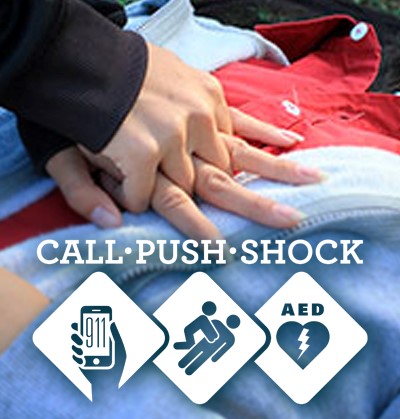ROSWELL, GA — Sam Hungerbuhler, of Cumming, was attending a basketball game for his stepson at Queen of Angels Catholic School in Roswell when the players started going to the ceiling.
At least that's what Hungerbuhler, 42, thought was happening.
"I was sitting there watching the kids going to the ceiling, but at the same time I was like 'Why are the kids going to the ceiling?'"
That was Hungerbuhler, 5-foot-5-inches tall and 160 pounds, passing out from a heart attack.
Hungerbuhler, a respiratory therapist at Children's Healthcare of Atlanta Scottish Rite, was in luck.
His wife, Trish, is a nurse at Children's and knew that Queen of Angels is equipped with an automated external defibrillator (AED) machine that tells users how many shocks are needed while medics are dispatched.
The game stopped, and game attendees stood around the edge of the basketball court saying prayers.
Another nurse helped with CPR — Cardiopulmonary resuscitation.
"She was doing the compressions and my wife was doing the mouth-to-mouth," Hungerbuhler said.
The nurse's husband, an anesthesiologist, held his jaw open.
"After the shock, the machine said keep doing the compression," said Hungerbuhler. "The machine told them what they needed to be doing."
Queen of Angels nurses Robin Spinner and Rae Ann Gruver were responsible for ensuring the AED batteries and pads were updated regularly.
"These roles are typical, crucial ones played by school nurses," said Sheila Vahey, Johns Creek Cluster Nurse for Fulton County Schools. "If the AED is not properly maintained, it won't work in an emergency when a life is on the line."
Schools that participate in Project SAVE (Sudden Cardiac Death: Awareness, Vision for Prevention and Education), created by CHoA to educate school systems and doctors about pediatric sudden cardiac death, have saved three lives — two adults and one student during the 2011-12 school year.
Hungerbuhler is grateful to have had a heart attack at a school equipped with life-saving gear. Hungerbuhler's right coronary artery had been completely blocked. He said he knew his family has a history of heart attacks, but he never thought it would happen to him.
"I never had chest pains, I was in good shape, I exercised and didn't think it would happen to me," he said.
All the physicians and nurses who treated him said he was "lucky."
Only 8 percent of Americans who suffer sudden cardiac arrest outside of a hospital survive. That's about 23,700 people who survive because of access to an AED, a John Hopkins University research shows.
In the New Year, Hungerbuhler has a fresh outlook on life.
"Being more positive and encouraging other people not to put it away like I did," he said. "Pay attention to your body, especially if you have a family history."
His friends have listened and have gone to get checked out.
"I feel great. I guess when you're used to living with it and it happens over time, you don't notice it," Hungerbuhler said. "Now I feel more awake and more aware."
SOURCE: Aldo Nahed, NorthFulton.com
